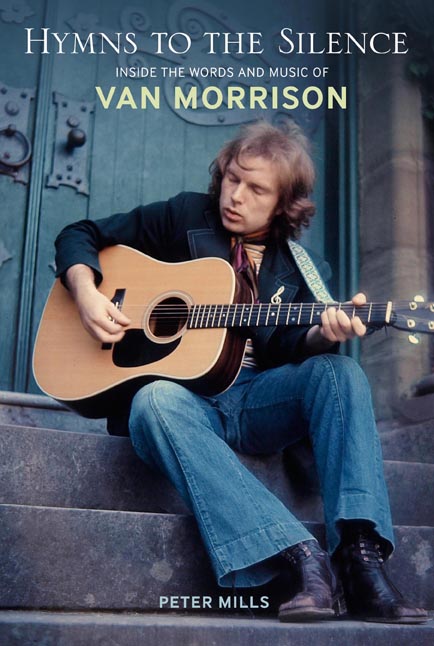 I’ve always had to call into question not just the musical taste of someone who claims not to like Van Morrison, but their entire being. For me, it would be like saying that ‘I don’t like to breathe fresh air’ or ‘I prefer to live in a dark cold cave’ than enjoy a sunshine day. Sure Van explores the dark side, in fact, I defy you to find a more troubled and tortured artist – one that can make Nick Drake look positively upbeat on a good day. Perhaps one of the reasons that I love Van, is that he basically satisfies nearly all my musical needs – he bridges the gap between Dylan and Ray Charles (if such a thing is possible and it is), his work with ‘Them’ defined garage AND punk. His trance-like jazz folk work rubs up with the best of Tim Buckley. He can sing a traditional song like “Wild Mountain Time” with as much conviction as Sandy Denny.
I’ve always had to call into question not just the musical taste of someone who claims not to like Van Morrison, but their entire being. For me, it would be like saying that ‘I don’t like to breathe fresh air’ or ‘I prefer to live in a dark cold cave’ than enjoy a sunshine day. Sure Van explores the dark side, in fact, I defy you to find a more troubled and tortured artist – one that can make Nick Drake look positively upbeat on a good day. Perhaps one of the reasons that I love Van, is that he basically satisfies nearly all my musical needs – he bridges the gap between Dylan and Ray Charles (if such a thing is possible and it is), his work with ‘Them’ defined garage AND punk. His trance-like jazz folk work rubs up with the best of Tim Buckley. He can sing a traditional song like “Wild Mountain Time” with as much conviction as Sandy Denny.
Van doesn’t suffer fools gladly, but does that mean he’s smarter than the rest of us? No, but it means that he’s read thousands of books – be it Samuel Beckett, Yeats, James Joyce, Alan Watts, Camus or even (help us), L. Ron Hubbard. Sure, I have no interest in Scientology, but damn it, at least when Van speaks of Hubbard, he’s not as ignorant as the rest of us –face it, we didn’t read it. We’re just judging shit based on rumor and myth. Van doesn’t fear the unknown, he’s searching it out. And for the record, Van is not part of that elite club with Tom Cruise and John Travolta, nor do I plan to be.
When I first began reading books about Dylan some two or actually three decades ago, I began with folks like Clinton Heylin, who were great at telling me what color shirt Bob was wearing in 1966 when he cut Blonde on Blonde – but Heylin and others could NOT capture the soul of Dylan, what it was about the music that moved them and us, the listener and reader. Then I discovered Paul Williams – his Performing Artist series on Dylan – which chronicles all of Dylan’s recorded work. Williams gave us some facts and dates, just enough to fill in the blanks, but what Williams did, which no other Dylan writer could do – was tell us what Dylan was feeling, what Williams was feeling, what we as the listener was feeling. Damn, it was the best psycho-therapy session you never had.
William got inside of the music – which is to say, he got inside the ‘heart’ of the music – and in fact, I will correct myself, he had no idea what Dylan was feeling, but he could occasionally grasp what inspired Dylan to write the song, what mood the song captured and in turn what we felt about it, how the sound of the vocals, words and music made us feel.
Now, someone has done that with Van! Hymns To The Silence; inside the words and music of Van Morrison by Peter Mills and published by Continuum is nearly 450 pages (no photos) of analysis of the soul. First of all, this is NOT a discography, you won’t find track by track and guest musicians lists here. There’s some interesting facts – such as “Bulbs” – that great R&B song that sort of sticks out of the Veedon Fleece album in a great, but weird way – was actually a song from a couple of years earlier, that Warner Brothers forced Van to include, because they didn’t hear a ‘single’ when Van turned the master tapes in the first time. But mainly the ‘facts’ are – what books and authors and traditional songs Van has borrowed from to write his classics. There’s much discussion of Van’s vocal phrasing – for me, it’s one of the things that makes Van great. The way that about 3/4ths of the way into “And It Stoned Me” – you can hear his voice rise and raise, taking a major leap forward with passion – Van is really feeling it now.
The book is not written in any chronological order, but divided into sections that focus on specific things. The first chapter explores how much ‘America’ has played into Van’s persona – jazz, blues, country, and the myth of the west – sure Van settled in Boston and then Woodstock, but ultimately it was California and the Bay Area in particular where Van found some sort of ‘peace.’ In fact when Astral Weeks was first released, 2/3rds of what that album sold, all sold within 100 miles of San Francisco, so it was obvious that the Bay Area “got his message.”
The next chapter dives into Van’s Irish heritage – and if anyone thinks that is simple, well then, explain to me in 50 words or less what are the religious, social, and political problems in Ireland over the past century? Other chapters; separate and divide Van as a songwriter, as a singer, as musician, as a performer – the difference between his live and studio performances.
At his best, Van’s studio recordings are basically live – like “Summertime in England” – and Van continually reworks those epics – if you haven’t experienced a 20 minute “Summertime” or a 15 minute “Cypress Avenue” – you haven’t experienced Van. Towards the end of the book, Mills begins to take specific songs and albums apart. Along the way, Mills peppers the text with a couple of one-off quotes from the Man himself (who of course has little to say about his own art) and in a couple of cases, he was able to get current and former Van sidemen to tell their story. Like Sinatra was, Van is notoriously guarded of his associates, if a Van-connected musician talks to the press, he might find himself out of a job.
There are 18 pages on Veedon Fleece alone! By now you’re getting worried, you’re thinking, is this some kind of academic blow-hard prose ala’ Greil Marcus disastrous attempt last year to squeeze Van’s creative juices into Marcus’ pop culture aesthetic?, where Marcus made lame attempts to compare Van’s songs with the movie The World According to Garp and a ‘long jump record’ set at the 1968 Olympics. No, it’s not. Like Paul Williams’ Dylan books, this book will not only inspire you, but force you to dig out your “Into the Music” LP and realize that “Full Force Gale” will certainly lift you up again. Read this book and let the healing begin.
– Pat Thomas is the author of the recently released work, Listen, Whitey! The Sights and Sounds of Black Power 1965-1975
http://youtu.be/yd_VqJkEC8Y
http://youtu.be/pEWWeuAjVn0


